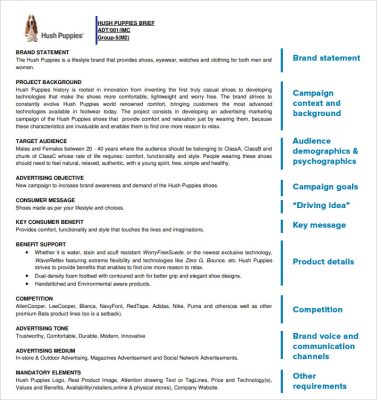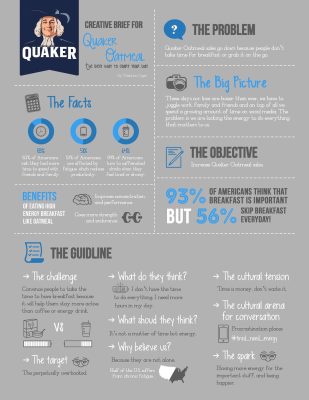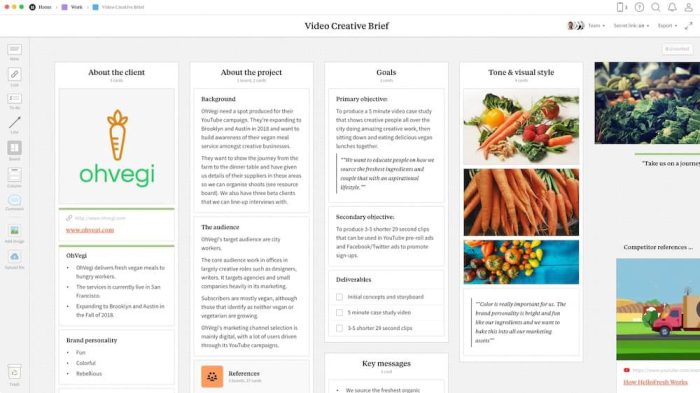https://nasacademy.com/blog/article/how-to-write-a-creative-brief-for-video

After you’ve signed onto a creative project, you might need to design what’s called a creative brief for a client or your internal team. You may have no idea what a “creative brief” means – or what you should include in it. But don’t worry, we’re here to give you all the information you need to make one for your next gig.
A creative brief is a document that holds all of the essential information around a creative project, all in one place. It’s a compilation of all the plans in the creative project to make sure that everybody has the same point of reference.
When beginning a project for a client, or even a project for your own brand where you are working for a team, drafting up a creative brief can help keep everyone in check when it comes to goals, timelines, budgets, and overall expectations of a given project.

Once you sign onto a project, you might be given a pre-crafted creative brief to follow by your client, but most of the time – and especially for any personal or internal projects – you and your team will be tasked with creating one yourselves.
There are different kinds of creative briefs that you can make depending on what the project is or that you are working on, but they all encompass relatively the same information and goal: to keep everyone on the same page.
Anytime you have a project that you are working on with a team, doing a creative brief is always a great practice. Crafting up a creative brief template or finding a free one online, is a great tool to help you save time, keep consistent across clients and projects, and make sure you’re never without a clear path when you begin a video project.
So, let’s walk through the 12 key things you’re going to want to include in your creative brief template.
Create a clear and engaging title for your project and place it at the top of your creative brief. Underneath, you could also include a short description that is either a catch-phrase or a general statement that encapsulates the general concept of the project.
Here, you’re going to expand on the project itself. You’re going to want to create an overview section that describes, in just a couple of sentences, what exactly this project is. What are the deliverables, what is the main reason for this project and what outcomes are you aiming for? You might want to include specific targets, metrics, or objectives that the brand is hoping to gain from it.

Be specific in what will be created, what formats will be used, and make sure to include the pain points or the problem that this project is going to address. You need to establish the why of this project, to help support the outcome of your video. As long as you identify both the need and the solution, this allows a focus for everybody to keep in mind as the project moves forward.
Especially if a brand is launching a product or a video that is catered towards helping a particular audience, highlighting the KCB (key consumer benefit) is a great way to focus and highlight the deep objectives from an audience standpoint. It defines the pain point that will be solved for the audience directly, and what they will get out of it.
With a key message, you’re going to elaborate and narrow in on the ultimate goal and specific outcome in terms of the message you are sending . What do you want your audience to feel? Your key message is the result that you want to achieve from your audience, and it shares the main focus of your project, to keep you aligned.
An important section to include in your creative brief template is a brand overview or background section. People need to know who this project is for, what their style, mission, and vision is so that the project outcome can accurately align with it. Who is the brand? What has brought them up to this point? How are they perceived, and what are the relationships or contributions that you will want to keep in mind or highlight in the final project?
Most importantly, for all kinds of content creation and marketing, you must know your target audience. In your creative brief, outline who this project is targeting. Who will be watching? What do you know about them and what do they need, want and think at the time of consuming this video?

The more information you can include while keeping it brief, the better. If everybody knows who they’re working to please, then the outcome will be much more targeted to that person. Some creative briefs will even expand into creating a specific persona for the project, and note their situations, ages, and interests.
Always know your competition. This can be a short part of your creative brief that outlines exactly where you stand, what your opportunities or threats might be, and where you are in relation to your competition. This is where you list what you have that’s different with this project, and how it’ll make you stand out amongst your rivals.
In this section of your creative brief, you’re going to want to include any necessary information as to how exactly your project will be shared. Note the platform, the distribution channel, and any important marketing content or strategies you plan to use.
While style and tone will be woven into the brief itself, it’s also important, especially for video, to establish some kind of style guide. What’s the look of the video going to be like? What are the colors and overall tone?
Think about everything from the camera angles, the framing, the color grading to the audio. Either provide some links to examples, or, create a mood board to give an idea of the visuals, and demonstrate exactly how you are going to show your story. This can make all the difference in how your idea is perceived, and how well it’s understood by everyone involved. This will help ensure there are no surprises, and your team can have confidence in what the end result will look like.
With most creative projects – especially those involving external clients – money is going to be involved. In your creative brief, you’re going to want to include a section that outlines any budget specifics that are to be kept in mind for the project. If there are any specifics in terms of how money should be spent or recorded, include it all here for reference. Break it down into sections if the client needs, or give a rough, overall estimate.

You’re going to want to outline any key deliverable dates for the project as well as the final deadline. Highlight any specific guidelines for when drafts are due, when revisions will be made or any important deadlines that need to be met to get your final deliverable done on time.
You may want to include a section that outlines specific stakeholders or people involved in the project to highlight and clarify any roles or specifics. This way, you are giving a rounded out view of who’s on the project, and who’s doing what.
Many creative briefs will often have a part that is dedicated to any miscellaneous information that is specific to the project at hand. Here, you can add any important notes, do’s, dont’s or anything that is important to note for this project that doesn’t fit into any of the other sections.
Creative briefs are supposed to be exactly that: brief. Make sure your brief is short, snappy, and easy to follow. Cut the fat, and don’t overcomplicate anything or include unnecessary information that clouds the important things. A best practice is, usually, to keep the entire document within 1-2 pages. Most of your sections will be summed up in only a couple of sentences. While it may be hard and take some time to refine – it is possible.
Also keep in mind that this post is simply a guide. Some creative briefs, depending on who you are working with, will vary in length and style. But what is consistently important, is keeping the main focus on the quality of content that appears on the document.
As a video creator, you’re working with a visual medium. So, it can really help to make your creative brief visual as well. While you don’t want the design to take away from the information, having a visual presentation that reflects the tone of your project can be a great way to demonstrate the creative look that’s in your head. Some might create their brief as a powerpoint, or simply add designs and customize the layout of their pages to be more of a visual experience.
This document is going to be a reference point for everyone on the team. The information has to be correct, clean and organized. Make sure to review, review, and review again. Have everyone on the team collaborate, meet up, and review it together. Take your time finalizing it to make sure it’s at a standard everybody is happy with, and get it to a point where it will successfully direct people through the project. Someone who has no idea what the project is about should be able to take a look at your creative brief, and know exactly what you’re working on.
You want to make sure to ask questions to your clients to get clear on everything that should be included on your brief. Ask them for any resources like brand bibles or if there are any requirements you should know about up front. This will help you gather all of the information you need to craft a detailed document to present them with.

But while this is important, many also caution new creators against asking too many questions up front, and taking too much creative inspiration or guidance from any clients. That is your job as the video creator, after all, and you want to be able to hold enough creative control to do it in the way you think is best.
You will find many different styles of creative briefs, from multi-paged powerpoints, to a basic one-pager. Or, you’ll find more visual ones like this one from studio binder that can be very powerful for visual projects, like videos. But what is ultimately important is you understand the expectations of the brief based on who you are writing it for, and that it only includes the necessary information to help you create your video.
It’s always good to look at some creative brief examples to get inspiration. As posted on Workamajig, these are some good examples of briefs that were created by some well-known brands, Hush Puppies and Quaker Oats:


And here’s a creative brief template made specifically for video, created by Milanote:

A creative brief is only the starting point for your project, and it is a guide that often changes as projects develop. But what is important, is that you have a collective understanding of your story, and you have a solid plan to start with. Then, you can move seamlessly into making the real magic happen, when you finally get to bringing that project to life.
5 years ago, the world had 5 million social media creators. Today, that number is over 50 million.
Welcome to the Creator Revolution. Now, for the first time ever, you can actually get a job doing what you love
You can be a social media manager, a digital marketer on TikTok, or a community manager on Discord. Not only are these the world’s newest jobs, they are guaranteed to be in-demand in future. And they are way more fun than your average 9 to 5, and pay even better! But there hasn’t been one single place to learn all these skills. Until now.
This is the Creator Accelerator Program. We designed this program to help you skyrocket your career as a creator. From learning how to grow on social media platforms, to building a network and accessing job opportunities with the world’s top brands – this immersive program will transform your career in just 5 months.
By Admin Nas Academy
By Admin Nas Academy